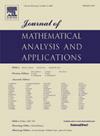The truncated multidimensional moment problem: Canonical solutions
IF 1.2
3区 数学
Q1 MATHEMATICS
Journal of Mathematical Analysis and Applications
Pub Date : 2025-03-27
DOI:10.1016/j.jmaa.2025.129524
引用次数: 0
Abstract
For the truncated multidimensional moment problem we introduce a notion of a canonical solution. Namely, canonical solutions are those solutions which are generated by commuting self-adjoint extensions inside the associated Hilbert space. It is constructed a 1-1 correspondence between canonical solutions and flat extensions of the given moments (both sets may be empty). In the case of the two-dimensional moment problem (with triangular truncations) a search for canonical solutions leads to an algebraic system of equations. A notion of the index of nonself-adjointness for a set of prescribed moments is introduced. The case corresponds to flatness. In the case we get explicit necessary and sufficient conditions for the existence of canonical solutions. These conditions are valid for arbitrary sizes of truncations. In the case we get either explicit conditions for the existence of canonical solutions or a single quadratic equation with several unknowns. Numerical examples are provided.
截断多维矩问题:规范解
对于截断多维矩问题,引入正则解的概念。也就是说,正则解是由在相关希尔伯特空间内交换自伴随扩展生成的解。它被构造为正则解与给定矩的平面扩展之间的1-1对应关系(两个集合都可以是空的)。在二维矩问题(三角形截断)的情况下,对正则解的搜索导致一个代数方程组。引入了一组给定矩的指标非自伴随的概念。情况is=0对应平坦度。在is=1的情况下,给出了正则解存在的显式充分必要条件。这些条件适用于任意大小的截断。在is=2的情况下,我们要么得到正则解存在的显式条件,要么得到带有多个未知数的单一二次方程。给出了数值算例。
本文章由计算机程序翻译,如有差异,请以英文原文为准。
求助全文
约1分钟内获得全文
求助全文
来源期刊
CiteScore
2.50
自引率
7.70%
发文量
790
审稿时长
6 months
期刊介绍:
The Journal of Mathematical Analysis and Applications presents papers that treat mathematical analysis and its numerous applications. The journal emphasizes articles devoted to the mathematical treatment of questions arising in physics, chemistry, biology, and engineering, particularly those that stress analytical aspects and novel problems and their solutions.
Papers are sought which employ one or more of the following areas of classical analysis:
• Analytic number theory
• Functional analysis and operator theory
• Real and harmonic analysis
• Complex analysis
• Numerical analysis
• Applied mathematics
• Partial differential equations
• Dynamical systems
• Control and Optimization
• Probability
• Mathematical biology
• Combinatorics
• Mathematical physics.

 求助内容:
求助内容: 应助结果提醒方式:
应助结果提醒方式:


